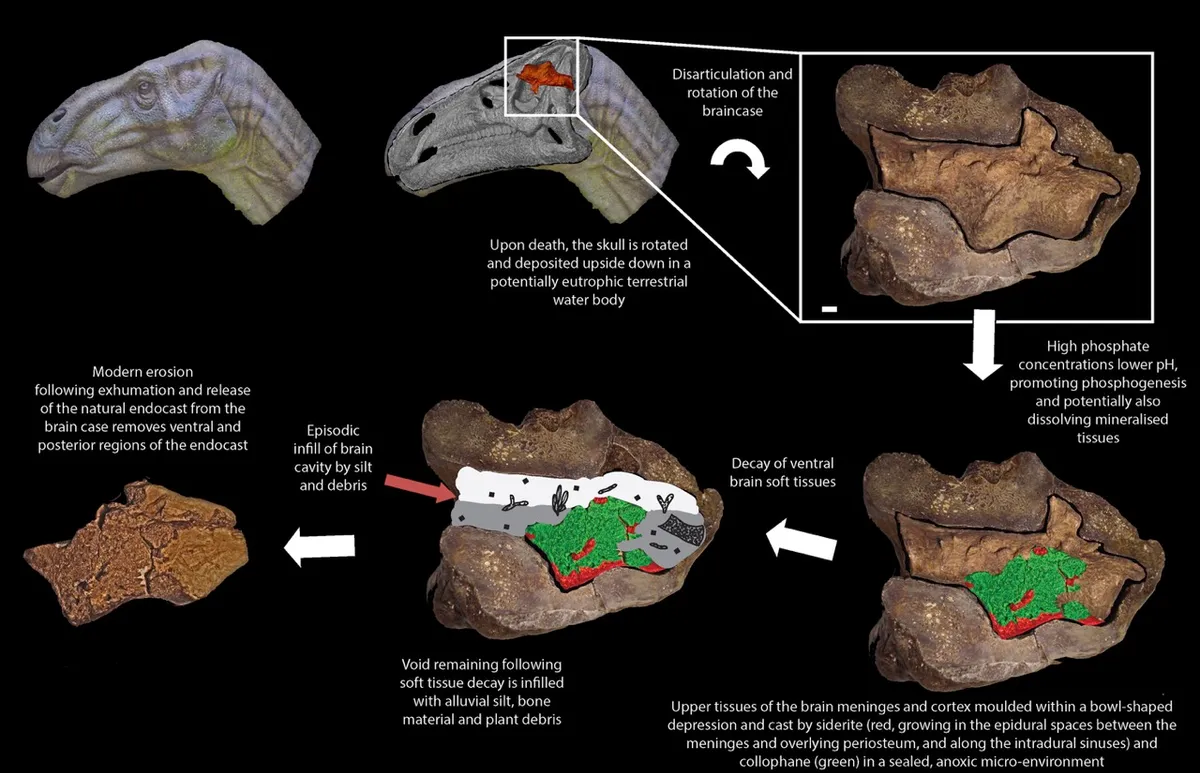Dinosaurs have a fearsome reputation for their hunting abilities but less so when it comes to their intelligence. This is partly due to the fact that many species have long been thought to have had relatively small brains, their heads full of protective tissue that supposedly left little room for grey matter. But the recent discovery of the first recorded fossilised brain tissue could help challenge that image.
The fossilised brain was found by a collector on a beach near Bedinxhill in Sussex, England. It preserves brain tissue of a large herbivorous dinosaur similar to Iguanodon, one of the first dinosaur species to be identified. Found among rocks laid down during the early Cretaceous Period around 133m years ago, the fossil is an endocast, formed as layers of sediment gradually filled up the skull.
Endocast fossils have been found before but what is unusual about this specimen is that the outer millimetre or so of the brain tissues themselves were mineralised. This means the fossil records some of the fine structure of the original tissues. Looking at the fossil with a scanning electron microscope (a powerful microscope that allows visualisation of very small structures) allowed us to study this structure in great detail.
This revealed evidence of the dinosaur’s meninges, the tough, collagenous outer membranes that protect the main brain. It also showed up tiny blood vessels preserved as tubes running across the surface of the specimen. There are even hints of deeper tissues that may have formed part of the brain cortex, the functional part of the brain that contains neurons.

We think this level of preservation was possible because the brain tissue was effectively pickled before it was mineralised, probably after the dinosaur died in a highly acidic and low-oxygen body of water. The soft tissues were preserved by phosphate and iron minerals, and CT (computed tomography) scans show the fossil also contains sediment, as well as fragments of leaves, twigs and bone.
Taken together, these observations create a picture of the dinosaur dying in a well-vegetated, swampy environment. Its head probably became buried in the sediment on a river- or lake-bed, and the lack of oxygen allowed the brain tissues to mineralise before they had a chance to decay.
While it is not surprising to find that dinosaurs had brains, it is remarkable that these tissues can be preserved for so many millions of years. Now that we know dinosaur brains can be preserved in this way, it might lead to further discoveries as scientists look back through museum collections to search for other specimens that could be studied in a similar way.
Bird-brained dinosaurs
This specimen may also reveal information about the size of dinosaur brains, which has been considered by some researchers as a rough indicator of their intelligence. The brains of modern reptiles such as crocodiles are often surrounded by thick protective tissues. Researchers have previously speculated that the brains of dinosaurs may have been similar, with actual brain tissue filling as little as half of the volume of the braincase.
But the brain fossil appears to show that in Iguanodon, the protective membranes were in the region of 1mm thick. This would suggest that the brain of this dinosaur filled the majority of the braincase, more like modern birds. That in turn could imply that Iguanodon had a greater intelligence than it has previously been given credit for. Being “bird-brained” was perhaps no bad thing after all. A caveat to this is that during the preservation process, gravitational settling of the brain within the braincase may have squashed the protective tissues prior to them being preserved, possibly making them appear thinner than they actually were.
Further work and more specimens are needed before this finding can be confirmed. But hopefully, greater recognition that such delicate tissues can actually be preserved in the fossil record will lead to more discoveries that advance our understanding of dinosaur behaviour and physiology.
Alex Liu, Lecturer in Palaeobiology, University of Cambridge.
This article was originally published on The Conversation. Read the original article.
Follow Science Focus onTwitter,Facebook, Instagramand Flipboard